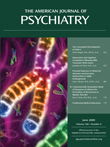Drs. Turetsky and Moberg Reply
To the Editor: Dr. Serby questions whether our observation of an odor-specific threshold deficit implicates cAMP-mediated signal transduction as a pathophysiological mechanism underlying olfactory deficits in schizophrenia. The basis of this concern is the finding that schizophrenia patients are impaired in their ability to detect geraniol (1) , an odorant that, similar to citralva in our study, is a relatively strong activator of adenyl cyclase. There are two aspects of this critique that require comment. The first concerns the strength of the evidence supporting a geraniol threshold deficit. The second is whether such a finding, if present, actually undermines our interpretation.
The evidence for a geraniol deficit was derived from a study of 14 patients reported in a letter to the Editor (1) . Important details such as the clinical status or smoking history of the patients, which can strongly affect olfactory performance, were not presented. The procedure to assess detection thresholds relied upon a single ascending method of limits, with very few stimulus presentations and no information concerning the actual odor concentrations. The validity of an ascending method of limits detection threshold procedure in which the apparent limen is crossed only once has been called into question, since it results in substantial inter- and intra-subject variability (2 , 3) . The procedure we used, a single staircase with seven required reversals, is more reliable and consistent and does not exhibit the marked intra- and inter-subject fluctuations seen with the ascending method of limits procedure (4) . These methodological shortcomings require that the study be replicated using more established procedures before the finding of a geraniol threshold deficit can be accepted with confidence.
However, even if schizophrenia patients are impaired in their ability to detect geraniol, this in no way alters the interpretation of our own data. In fact, consistent with the idea of a geraniol deficit, we specifically noted (5) that a subset of the patients in our study exhibited significant threshold deficits for citralva. However, the critical finding in our data was the differential deficit for lyral relative to citralva in both patients and unaffected family members. These subjects exhibited a relative impairment in their ability to detect lyral, independent of their baseline sensitivity to citralva. Neither the presence nor the absence of a citralva (or geraniol) deficit offers any insight, by itself, into this relative impairment or its significance.
We would also note that we never suggested that cAMP-mediated signal transduction abnormalities are the sole basis for the olfactory impairments observed in schizophrenia. We actually agree completely with Dr. Serby’s conclusion that “odor detection deficits may have a more complex explanation than the specific signal transduction mechanism cited.” This does not discredit this specific mechanism as comprising one aspect of that complex explanation. Finally, it is important to emphasize that no behavioral study can definitively confirm or disprove a molecular hypothesis. The most that can be offered is strong inferential evidence to support a hypothesis and motivate further investigation. We firmly believe that our findings provide such a strong inference and that additional studies of this intracellular signaling pathway, along the lines suggested by Sawa and Cascella (6) , are clearly warranted.
1. Serby M, Larson P, Kalkstein D: Olfactory sense in psychoses. Biol Psychiatry 1990; 28:830Google Scholar
2. Brown KS, Maclean CM, Robinette RR: The distribution of the sensitivity to chemical odors in man. Hum Biol 1968; 40:456–472Google Scholar
3. Stevens JC, Cain WS, Burke RJ: Variability of olfactory thresholds. Chem Senses 1988; 13:643–653Google Scholar
4. Doty RL, Laing DG: Psychophysical measurement of human olfactory function, including odorant mixture assessment, in Handbook of Olfaction and Gustation, 2nd, ed. Edited by Doty RL. New York, Marcel Dekker, 2003, pp 338–381Google Scholar
5. Turetsky BI, Moberg PJ: An odor-specific threshold deficit implicates abnormal intracellular cyclic AMP signaling in schizophrenia. Am J Psychiatry 2009; 166: 226–233.Google Scholar
6. Sawa A, Cascella NG: Peripheral olfactory system for clinical and basic psychiatry: a promising entry point to the mystery of brain mechanism and biomarker identification in schizophrenia. Am J Psychiatry 2009; 166:137–139Google Scholar



